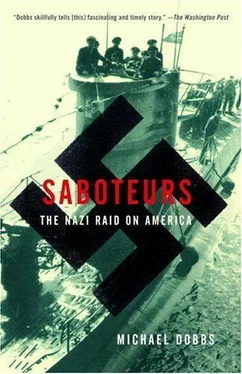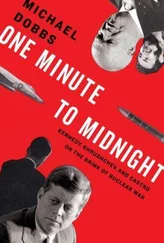As an egomaniac, he likes to picture himself in two characters, one of George John Dasch and the other of George John Davis. George Davis is a stool pigeon, an informer and a traitor to the German government. [This] is the individual who is furnishing all the information in this case and who immediately reported his landing to the FBI in order that no sabotage would occur and no lives would be lost. On the other hand, George Dasch is the individual who is fighting for the German people, the true people of Germany who are opposed to the things that Hitler stands for. He believes these people to be in the majority in Germany at the present time but feels they are coerced into following Hitler’s methods and program. This is the individual who will take part in the reconstruction of Germany after the war.
Dasch could be exasperating. Asked to describe the formulas for explosives that he had studied at Quenz Lake, he told Traynor he had not paid much attention. “If I like something, I learn it; if I don’t like it, I don’t learn it.” On the other hand, he continued to provide useful information that could be used to track down his fellow saboteurs. At first he could not remember the real name of the fourth member of Kerling’s group, who used the alias William Thomas, even though they had both traveled back to Germany together on the Tatuta Maru. Traynor tried to jog his memory by reading names beginning with “Th” from a telephone book, on the theory that the saboteurs used the same initials for their assumed name as for their real name. When he got to “Thiel,” Dasch stopped him.
“Thiel! That’s his real name. Werner Thiel. If you look through the records of the Nazi Bund, you will find him.” 28
On Sunday evening, Dasch suddenly remembered the name of the “smelly” chemical that would bring out the secret writing on the handkerchief he had shown Traynor during their first meeting. “Ammonia,” he said excitedly. “I passed the handkerchief over a bottle of ammonia… It shows red until it dries. You read it slowly and then it goes away again. You have to do it slowly. Just pass it over ammonia water.” 29
By Monday morning, the FBI laboratory had deciphered four names and addresses, and concluded that the ink used for the secret writing was “undoubtedly phenolphthalein, a constituent of the most common laxatives.” 30Traynor and Dasch were soon poring over photographic enlargements of the handkerchief, trying to figure what the cryptic words meant.
“What the hell is ‘Bingo’?” Dasch wracked his brain or, as he affectionately called it, his “noodle.” “Now wait a minute. ‘Bingo’ is the name of this little kid Haupt. That is the name under which he is known in the German High Command.” 31
Next to “Bingo” was the name Walter Froehling, Haupt’s uncle and contact person. “This is to be used in case we decide at our headquarters to find a farm, a hideout where we put the boxes. This Walter Froehling is either a relation of his or a friend or something to do with the Bund.”
On the next line, Dasch found the name Helmut Leiner, with an address in Astoria, Queens. “He is a very good friend of Kerling… We agreed that any time I lost track of this Kerling guy, I should always get in touch with Leiner. He would tell me where this Kerling is to be found.”
By lunchtime, Traynor’s superiors had sent messages to FBI offices in New York and Chicago, ordering surveillance of everybody named on the handkerchief. In the meantime, Hoover prepared a memorandum for President Roosevelt reporting that the FBI had “apprehended all members of the group which landed on Long Island,” who were being held “secretly and incommunicado.” 32He emphasized his own personal role in cracking the case, even though he had not yet spoken to any of the saboteurs:
I have taken detailed statements from each of the persons arrested and the story is a startling and shocking one. Long and extensive training is being given by the German authorities to specially selected men who in turn are being placed on board German submarines to be landed on the shores of the United States. The group which landed at Amagansett, Long Island, on June 13, 1942, was the first group to arrive in this country. The second group were landed approximately the same time on the coast of Florida. I expect to be able to have in custody all members of the second group. I am definitely informed that additional groups will be sent from Germany to the United States every six weeks to initiate a wave of terror within the United States by the commission of acts of sabotage against many of our key industries, factories, electric power systems and waterworks. I have been able to secure a list of these facilities that were to be included in the first acts of sabotage.
What Hoover failed to mention in the memorandum was that far from being “apprehended,” the leader of the saboteurs had turned himself in to the FBI voluntarily after being dismissed initially as a “crank.” That was the kind of extraneous detail that would only serve to “embarrass” his beloved Bureau.
THE FBI had been unable to find Herbie Haupt over the weekend, despite placing his parents’ home under surveillance. On Monday morning, Haupt made the Bureau’s job a lot easier.
At his parents’ insistence, he registered for the draft. After visiting the local draft board and formally receiving a draft card, he took a taxi to the Chicago headquarters of the FBI. He told the receptionist he had just returned from Mexico and wanted to clear up questions regarding his draft status. The receptionist referred him to the complaint desk, where he explained that he had run away from home to avoid getting married.
Haupt’s statement to the FBI was a mixture of truth, lies, and concealment. He omitted any mention of his trip to Germany, saying he had spent most of the last year in the mountains of southern Mexico living with Indians and prospecting for gold. His biggest problem was how to explain away the cable he had sent his parents from Japan while on the way to Germany. His mother had told FBI agents about the telegram the previous December, when they came looking for him, so he could hardly deny its existence. Instead he claimed that he himself had never been in Japan: the telegram had been sent by a friend acting on his behalf. He had wanted to convince his former girlfriend that he would not be returning home for a very long time. In order to deceive her, it had been necessary to deceive his parents as well.
The FBI agent seemed to accept this explanation, asking merely if Haupt would fight for the United States if drafted. “I would rather not fight against the German people,” he replied coolly. 33“But if I have to go to war, I will go.” To Herbie’s relief, he was then permitted to leave. “We have no further interest in you,” the agent told him.
In the meantime, Assistant FBI Director Connelley had arrived in Chicago, charged by Hoover with ensuring “proper coverage” of the friends and relatives of Haupt and Neubauer. 34Hoover was unhappy with the performance of the Chicago office and wanted Connelley to “straighten out the matter.” Connelley assigned more agents to watch the Haupt residence, and was soon rewarded: at 12:25 p.m., the agents reported “a man fitting the description of the subject get out of a Yellow taxi” and enter the house. 35Herbie had returned home following his visit to the FBI.
Rotating teams of agents proceeded to follow him for the rest of the day, as he visited bars, old friends, and his former boss at Simpson Optical Company, where he had worked as an optician before going to Mexico. The agents were under instructions not to arrest Haupt: they hoped he would lead them to Neubauer and perhaps to other members of his group.
ALTHOUGH HEDY ENGEMANN had not seen Kerling for over two years, her feelings toward him were as strong as ever. She had a vivid memory of their first meeting in Miami, at a time when he was being chased by the Coast Guard on suspicion of planning to sail his yacht Lekala to Germany illegally. A friend had arranged a double date, telling Hedy she had come across someone “very exciting.” They had spent the day “fooling around” onshore, and he had then taken her back to the Lekala for the night. It was a lot of fun.
Читать дальше












